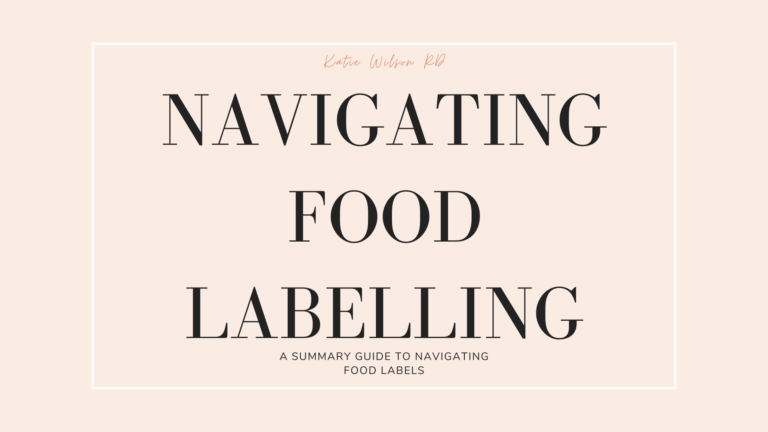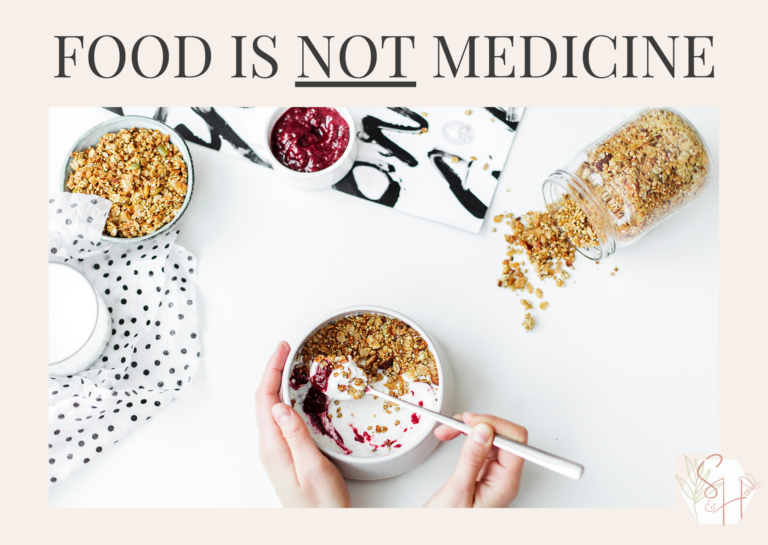It’s tempting to have an “all or nothing” approach with our eating habits, especially when we’re looking to make improvements to our health. But when it comes to long-lasting, sustainable behaviour change, this doesn’t come from making dramatic changes overnight. Slow, consistent change is the way to go, and sometimes we don’t need to overhaul our entire diet in order to make progress.
There are tons of small ways we can improve our eating habits, but today I wanted to focus on some foods to add into your current meals to increase nutrition content a little. Like little nutrition sprinkles, so to speak.
A caveat to this entire post though – while I’m giving specific suggestions, these are all things I think are easy to add to your current diet. Dietary patterns, not specific foods, are key. Any health outcomes associated with “a diet high in [insert certain food here]”, is often the result of overall healthy lifestyles and eating patterns – not that specific food in and of itself. So keep that in mind. Once again, these foods are all recommended parts of a wider, balanced, and varied diet.
That aside – let’s get into it.
1. Beans & Lentils
Here in the UK, we’re used to basing our meals on meat. While there’s absolutely nothing wrong with including meat in the diet from a health perspective, many people get defensive when plant-based proteins are suggested as an alternative. However, one of the reasons I think this is is because it’s often interpreted as having to choose between one or the other – meat, or full-blown veganism. But that’s simply not true! You do not need to completely exclude meat from the diet in order to increase your intake of plants!
Adding beans and lentils into the diet on a regular basis is a fantastic way to increase fibre intake and lower saturated fat intake, all while providing adequate protein. My stance with nutrition has always been that the more diverse your diet is, the better. Evidence shows that including a variety of plant foods in the diet is associated with significantly improved health outcome, while often costing less money and reducing your carbon footprint. How can you not be interested?
Try switching out half, or even a third, of the mince in a lasagne, for example, with lentils. Make a curry with chick peas instead of chicken once a week, or once every two weeks to begin with.
2. Mixed Nuts & Seeds
I can bet you that a significant chunk of the population never eat nuts and seeds unless they’re covered in salty or sugary seasonings. But out of all these tips, this has to be one of the easiest to implement.
Nuts and seeds are high in fibre, healthy fats, and micronutrients, and studies have actually shown that despite their relatively high-calorie content, increasing consumption of whole, plain nuts, does not result in weight gain. Instead of focusing on calorie targets, a more important goal is aiming for over thirty different plant foods per week, in order to optimize health and increase nutrition status. Adding a sprinkle of mixed nuts or seeds to salads, curries, casseroles, smoothies, porridge (almost anything you can think of) has to be one of the easiest ways to wrack up your plant points for the week!
If you’re starting out and are not a fan of the concept, start off super easy – add chia seeds to a smoothie, almond flakes to a curry, cashews to a stir fry, or even a tbsp of ground almonds into your porridge (I promise you you’ll barely, if at all, notice this!).
If you’re more on board, I would even suggest keeping a jar of mixed seeds on your table along with salt and pepper. Get used to just adding a sprinkle to every meal!
I also love to jazz up some 80%-85% dark chocolate by making healthy chocolate bark. To recreate this, melt the chocolate in a double-boiler or the microwave, and stir in a variety of nuts and seeds, and dried fruit too (I made some this morning with 1 bar dark choc, 4tbsp desiccated coconut, a handful dried mango, a handful of pistachios lightly chopped and 2tbsp each of chia seeds, flaxseeds, sunflower seeds and pumpkin seeds). Pour onto a lined baking tray and allow to set in the fridge before breaking into chunks. Super simple and delicious!
3. Olive Oil
The “low fat” trend of the 1990s-2000s has been a hard one to shake. While there are certain products and situations low fat may be beneficial, there is substantial evidence that reducing saturated fat, rather than total fat, is the key to improve health. Despite this though, there is still a general fear of fat amongst the general public. This goes hand-in-hand with our obsession with low-calorie foods; a food high in fat, no matter the type, is not going to be low-calorie. But we need to stop associating high-calorie as “bad” and low-calorie as “good”, without considering the nutritional composition as a whole.
Populations who consume a lot of nuts, seeds, plant oils, and oily fish often have longer healthy life expectancies than Westernised civilizations (not to mention lower rates of obesity – go figure). The Meditteranean diet is one most often talked about (but by no means the only healthy cultural diet), which is well known for its focus on monounsaturated and polyunsaturated fats, from oily fish and olive oil for example. A commonly used “Meditteranean Diet Score Tool”, proposes that >4tbsp of olive oil be consumed a day to improve health outcomes associated with such an eating pattern.
Olive oil is not necessarily the only option – walnut oil, rapeseed oil and flaxseed oil (to name a few) are all good choices. But consider implementing these more readily into your diet. Including oils and healthy fats adds a heap of flavour, and helps to make a dish much more satiating (this is likely why increasing intake of healthy fats is not inherently associated with higher body weight). They are also hugely beneficial for heart and brain health, contributing to better energy levels, mood, focus, and possibly better mental health as well. Since hormones are actually made from fat, ensuring adequate fat intake is also crucial for a healthy hormone balance, which has shown to be particularly important in women’s health. I could go on, but I hope this is enough to show you – fat is not to be feared! If you are looking to increase nutrition content of your diet, you can’t avoid healthy fats.
While we often only use oil to cook with, some of the best benefits will come from adding oils after cooking. So consider swirling a tbsp of olive oil into your bowl of soup, making a salad dressing based on olive oil, or even adding a tbsp of a lighter-flavoured oil (e.g. flaxseed oil) to a smoothie.
4. Berries
Another super simple way to boost the nutrition of a meal is to add berries. I hope it goes without saying that all fruit and vegetables are healthy, and there’s no one superior to the other. Once again – the best thing you can do is get the biggest range as possible!
Berries provide an amazing source of essential vitamins and minerals, including Vitamin C and folic acid. However, alongside these, berries provide a particularly rich concentration of phytochemicals (chemicals naturally found in plants that have shown to have benefits on human health), such as anthocyanins (responsible for the rich reds and purples of berries). These have been associated with having high antioxidant and anti-inflammatory activities and may help to reduce risks of cancer and heart disease. While the relative importance of these phytochemicals is yet to be determined, berries are undoubtedly a great addition to the diet – and are something that few people dislike! Fortunately, most berries also grow seasonally in Northern hemispheres, so in terms of air-miles and carbon footprint, we’re all good. Try to choose options grown as close to home as possible.
I try to include berries as part of my daily diet – whether on their own as a snack, or added into a smoothie, a yoghurt, or on top of porridge or cereal.
5. Celery
Okay, this one’s a bit random I’ll admit. The reason why I included this one isn’t so much because celery has any “magic” properties (don’t even get me started on celery juice *BIGGEST eye roll*). But if you listen to my podcast, I’ve already brought this up at least twice.
Increasing our intake of plants is a fantastic way to improve health, and increase nutrition status. A rough guide to help with this is to aim for >1/2 of your dinner plate to be filled with vegetables. When I say this to people in clinic, I’m often met with a blank stare or an attempt at a placating nod that’s clearly just for my benefit. But when I break it down, people start to see that filling half the plate with a mound of peas isn’t necessarily what I mean. One of these strategies is adding more veg into the meal itself when making things like casseroles, curries, chillis or stews. For those who are on the picky side, celery is a godsend.
While raw celery is probably a less popular vegetable, it is virtually undetectable when added into a dish. It adds minimal/no flavour, cooks to a soft texture (similar to cooked onion), and can be chopped up as small as you need to cater to you or your family. Give it a go!
6. Dark, Leafy Greens
I think of dark, leafy greens as the “berries” of the veg world – again, all vegetables are equally as important. But, compared to something like iceburg lettuce, darker coloured greens pack more of a punch.
A diet high in dark, leafy greens is associated with lower rates of obesity, heart disease, cancers, type 2 diabetes and cognitive decline. They boast an incredible profile of vitamins, such as Vitamin A, C, E, K and B-vitamins such as folate, as while as fibre, iron, magnesium, potassium, and phytochemicals. Aim for 2-3 servings per day of options such as kale, spinach, broccoli, sprouts, cabbage, collard greens, bak choi or rocket.
Implement these by using as the base for a salad or in sandwiches or wraps instead of iceburg lettuce, add kale, broccoli or spinach to soups and stews, or throw into an omelette. Spinach, in particular, is an easy addition as it wilts down so much – so you can add in a heft portion without it overtaking the entire dish.
Due to the high content of fat-soluble vitamins (A, E and K), this is also the perfect opportunity to implement your salad dressing based on olive oil (pairing fat with sources of fat-soluble vitamins aids their absorption). Alternatively, pair with oily fish or some avocado.
7. Colour
This goes back to point #5. As I keep mentioning, our main goal should be increasing variety, particularly of plant foods, into our diet. The easiest way to think about this is colour – so as you’re preparing a meal, think about how many colours are present. This is also a great way to get kids on board and teach them about cooking and healthy eating – make it into a fun game they can participate in!
How can you add more colour to your dish? Where’s the red? Make a sauce based on chopped tomatoes. Greens? Add a handful of spinach and chopped celery. Yellow? A chopped yellow pepper. Orange? In go some carrots. White? Garlic it up. Purple? Red onion.
Not every single meal needs to be perfect, or filled with every colour under the sun. Sometimes, I want white pasta with butter – is that too much to ask? BUT, if you do this throughout your day, week and month – you’ll be well on the way to boosting that nutritional intake!
To learn more about creating healthier eating habits, take a look at my post about Navigating Food Labels or learn from the world’s healthiest civilisations.



